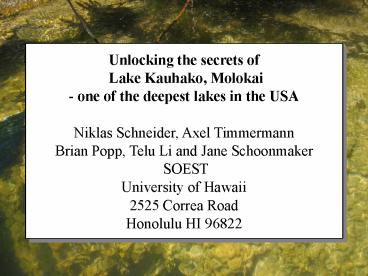m - PowerPoint PPT Presentation
1 / 22
Title: m
1
Unlocking the secrets of Lake Kauhako,
Molokai - one of the deepest lakes in the
USA Niklas Schneider, Axel Timmermann Brian
Popp, Telu Li and Jane Schoonmaker
SOEST University of Hawaii 2525 Correa
Road Honolulu HI 96822
m
2
Lake Kauhako the 4th deepest lake in the US
3
Geography
- Lake Kauhako is a volcanic crater lake located on
the Kalaupapa Peninsula on the north shore of
Molokai. - Latitude/Longitude 21 11 N 156 58' W)
4
Characteristics
- The lake is the fourth deepest lake in the United
States - The lake with the highest ratio of depth (248 m)
to surface area (3500 sq. meters) in the world .
- Upper 4.5 m stratified (T 23 - 26 C salinity
6 24.5) (pycnocline) - below pycnocline water column is homogenous (T
26.25 C salinity 32), - below pycnocline water column is anoxic
- No tides presently, but anecdotal reports of
tides in the 1960s - approximate age of crater lake several 100,000
years.
5
Research Team
- Niklas Schneider climate dynamics, North Pacific
climate - Axel Timmermann paleo-climate, El Nino, climate
modeling, - Brian Popp stable isotope biogeochemistry,
paleooceanography - Jane Schoonmaker sedimentary geochemistry and
diagenesis - Telu Li Aquatic chemistry of lakes,
biogeochemical cycles - Barry Rolett archeology of Polynesia and
Southeast Asia
6
What the Kauhako may tell us
- Reconstruction of Hawaiian climate
- Reconstruction of vegetation history
- Reconstruction of megatsunamis
- Reconstruction of volcanic eruptions
- Underwater archeology
- Understanding biogeochemistry of anoxic lakes
7
Objectives
- Drilling of sediment core for the reconstruction
of Hawaii's climate, and vegetation history - Exploration of lake bottom, archeological
artefacts, living organisms - Exploration of biogeochemical processes operating
in Lake Kauhako - Acoustic exploration of lake bottom
8
Synergistic activities at SOEST
Paleoclimate Dynamics
Geology
Astrobiology
Lake Kauhako
Biogeochemistry
9
Logistics
- Hiking down equipment
- Use of barge to transport
- equipment to Kalaupapa
- Working platform on lake
- needed
- Kalaupapa is administered
- by the National Park Service
- Special permits are required,
- but easy to get
- Park service extremely helpful
dangerous
Mixing can kill endemic fauna
10
Field equipment needed
- ROV for bottom exploration, samples, guidance of
the drilling - Gravity corer
- Working platform
- Niskin bottles for water sample collection
- Echosounder
- CTD for temperature and salinity measurements
(can be borrowed from NOAA lab)
11
Microbial mats and subpycnocline carbonate
structures
- The mats below 5m are partly composed of sulfate
reducing bacteria. - Their action causes the alkalinity to increase to
above 10 meq/l (seawater 2.3 meq/l). - When mixed to the surface layer, this excess
alkalinity leads to a high calcium carbonate
saturation causing microbially mediated
non-enzymatic calcium carbonate precipitation. A
system like this is called an alkalinity pump
and is important for the understanding of
stagnating oceans as occurred in the geologic
past - (from Kempe)
12
Sulfate reducing bacteria
1 2 3 4 5 6 7 8 9
1 2 3 4 5 6 7 8 9
From Donachie
13
Temperature and salinity structure
- Brackish surface water
- Sharp pycnocline at 5 m
- Temperature at 248m 26C
- Geothermal heating important
- Age of water unknown
From Donachie
14
Step I, accomplished in 2006
- Soundings (maximum depth 243 m)
- Measuring temperature and salinity structure
down to 200m using CTD - Exploration of easiest access for future
expeditions - Water samples
15
Step II founding sought for exploration of lake
bottom with remote operating vehicle (ROV)
- The goal of the second field expedition is to
explore the bottom of Lake Kauhako, the access to
the sediments, the existence of possible lava
tubes and the sediment structure using
echo-sounding
16
Remote operating vehicle (ROV)
- Depth range 300m
- Includes glas fiber cable, remote control, power
supply, grabber, cameras - High quality video
17
(No Transcript)
18
Estimated equipment budget for STEP II
- ROV rental 10,000
- Working platform, 2 zodiaks 2,000
- Helicopter transportation to Kalaupapa 3,000
19
Previous publications on Kauhako
1. Donachie, S.P. ,R.A. Kinzie III, D.W.
Saddler ,R.R. Bidigare and D.M. Karl. 1999. Lake
Kauhako, Molokai, Hawaii Biological and
chemical aspects of a morpho-ectogenic
meromictic lake. Aquat. Microbiol. Ecol . 19(1)
93-103.) 2. Garmin, M. Garmin, S. Kempe, S.
(2000) First deep dives into Kauhako Crater
Lake, Molokai a deep volcanic vent dominated by
microbial lif. Abstr. Nat. Speleol. Soc.
Convention 2000. 3. J.A. Maciolek, 1982 Lakes
and Lake-like Waters Of the Hawaiian
Archipelago, Occasional paper of Bernice P.
Bishop Museum, XXV (1), 1-14.
20
Gravity corer
- A gravity sediment corer is needed to extract
sediment from the lake bottom - The ROV might be needed to guide the coring
- Sediments will be analyzed at SOEST
- Pollen analysis will be done in other labs
21
AppendixProfiles from Donachie
22
Biogeochemical properties
23
Biogeochemical properties































